56 9.11 Characteristics of Fungi
Mary Ann Clark; Jung Choi; and Matthew Douglas
Although humans have used yeasts and mushrooms since prehistoric times, until recently, the biology of fungi was poorly understood. In fact, up until the mid-20th century, many scientists classified fungi as plants! Fungi, like plants, are mostly sessile and seemingly rooted in place. They possess a stem-like structure similar to plants, as well as having a root-like fungal mycelium in the soil. In addition, their mode of nutrition was poorly understood. Progress in the field of fungal biology was the result of mycology: the scientific study of fungi. Based on fossil evidence, fungi appeared in the pre-Cambrian era, about 450 million years ago. Molecular biology analysis of the fungal genome demonstrates that fungi are more closely related to animals than plants. Under some current systematic phylogenies, they continue to be a polyphyletic group of organisms that share characteristics, rather than sharing a single common ancestor.
Career Connection: Mycologist
Mycologists are biologists who study fungi. Historically, mycology was a branch of microbiology, and many mycologists start their careers with a degree in microbiology. To become a mycologist, a bachelor’s degree in a biological science (preferably majoring in microbiology) and a master’s degree in mycology are minimally necessary. Mycologists can specialize in taxonomy and fungal genomics, molecular and cellular biology, plant pathology, biotechnology, or biochemistry. Some medical microbiologists concentrate on the study of infectious diseases caused by fungi, called mycoses. Mycologists collaborate with zoologists and plant pathologists to identify and control difficult fungal infections, such as the devastating chestnut blight, the mysterious decline in frog populations in many areas of the world, or the deadly epidemic called white nose syndrome, which is decimating bats in the Eastern United States.
Government agencies hire mycologists as research scientists and technicians to monitor the health of crops, national parks, and national forests. Mycologists are also employed in the private sector by companies that develop chemical and biological control products or new agricultural products, and by companies that provide disease control services. Because of the key role played by fungi in the fermentation of alcohol and the preparation of many important foods, scientists with a good understanding of fungal physiology routinely work in the food technology industry. Oenology, the science of wine making, relies not only on the knowledge of grape varietals and soil composition but also on a solid understanding of the characteristics of the wild yeasts that thrive in different wine-making regions. It is possible to purchase yeast strains isolated from specific grape-growing regions. The great French chemist and microbiologist, Louis Pasteur, made many of his essential discoveries working on the humble brewer’s yeast, thus discovering the process of fermentation.
Cell Structure and Function
Fungi are eukaryotes, and as such, have a complex cellular organization. As eukaryotes, fungal cells contain a membrane-bound nucleus. The DNA in the nucleus is wrapped around histone proteins, as is observed in other eukaryotic cells. A few types of fungi have accessory genomic structures comparable to bacterial plasmids (loops of DNA); however, the horizontal transfer of genetic information that occurs between one bacterium and another rarely occurs in fungi. Fungal cells also contain mitochondria and a complex system of internal membranes, including the endoplasmic reticulum and Golgi apparatus.
Unlike plant cells, fungal cells do not have chloroplasts or chlorophyll. Many fungi display bright colors arising from other cellular pigments, ranging from red to green to black. The poisonous Amanita muscaria (fly agaric) is recognizable by its bright red cap with white patches. Pigments in fungi are associated with the cell wall and play a protective role against ultraviolet radiation. Some fungal pigments are toxic to humans.
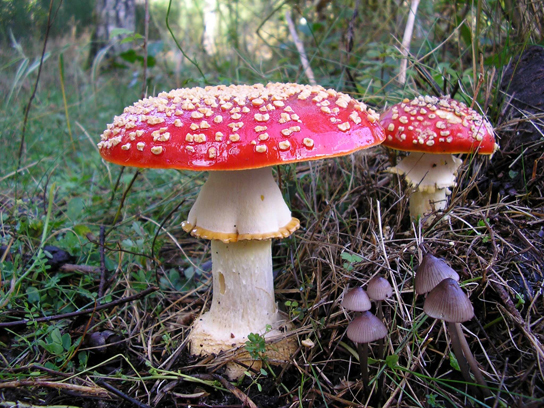
Like plant cells, fungal cells have a thick cell wall. The rigid layers of fungal cell walls contain complex polysaccharides called chitin and glucans. Chitin (N-acetyl-D-glucosamine), also found in the exoskeleton of arthropods such as insects, gives structural strength to the cell walls of fungi. The wall protects the cell from desiccation and some predators. Fungi have plasma membranes similar to those of other eukaryotes, except that the structure is stabilized by ergosterol: a steroid molecule that replaces the cholesterol found in animal cell membranes. Most members of the kingdom Fungi are nonmotile. However, flagella are produced by the spores and gametes in the primitive Phylum Chytridiomycota.
Growth
The vegetative body of a fungus is a unicellular or multicellular thallus. Unicellular fungi are called yeasts. Multicellular fungi produce threadlike hyphae (singular hypha). Dimorphic fungi can change from the unicellular to multicellular state depending on environmental conditions. Saccharomyces cerevisiae (baker’s yeast) and Candida species (the agents of thrush, a common fungal infection) are examples of unicellular fungi.
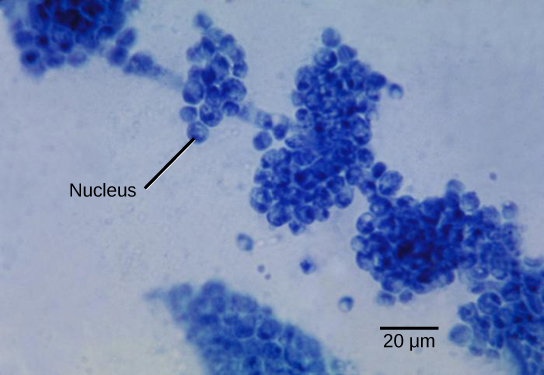
Most fungi are multicellular organisms. They display two distinct morphological stages: the vegetative and reproductive. The vegetative stage consists of a tangle of hyphae, whereas the reproductive stage can be more conspicuous. The mass of hyphae is a mycelium. It can grow on a surface, in soil or decaying material, in a liquid, or even on living tissue. Although individual hyphae must be observed under a microscope, the mycelium of a fungus can be very large, with some species truly being “the fungus humongous.” The giant Armillaria solidipes (honey mushroom) is considered the largest organism on Earth, spreading across more than 2,000 acres of underground soil in eastern Oregon; it is estimated to be at least 2,400 years old.
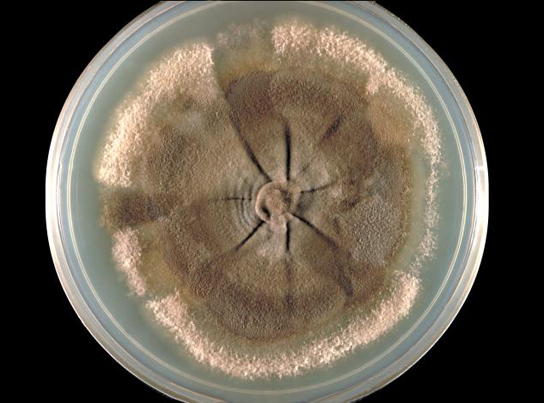
Most fungal hyphae are divided into separate cells by endwalls called septa (singular, septum). In most phyla of fungi, tiny holes in the septa allow for the rapid flow of nutrients and small molecules from cell to cell along the hypha. They are described as perforated septa. The hyphae in bread molds (which belong to the Phylum Zygomycota) are not separated by septa. Instead, they are formed by large cells containing many nuclei (multinucleate), an arrangement described as coenocytic hyphae
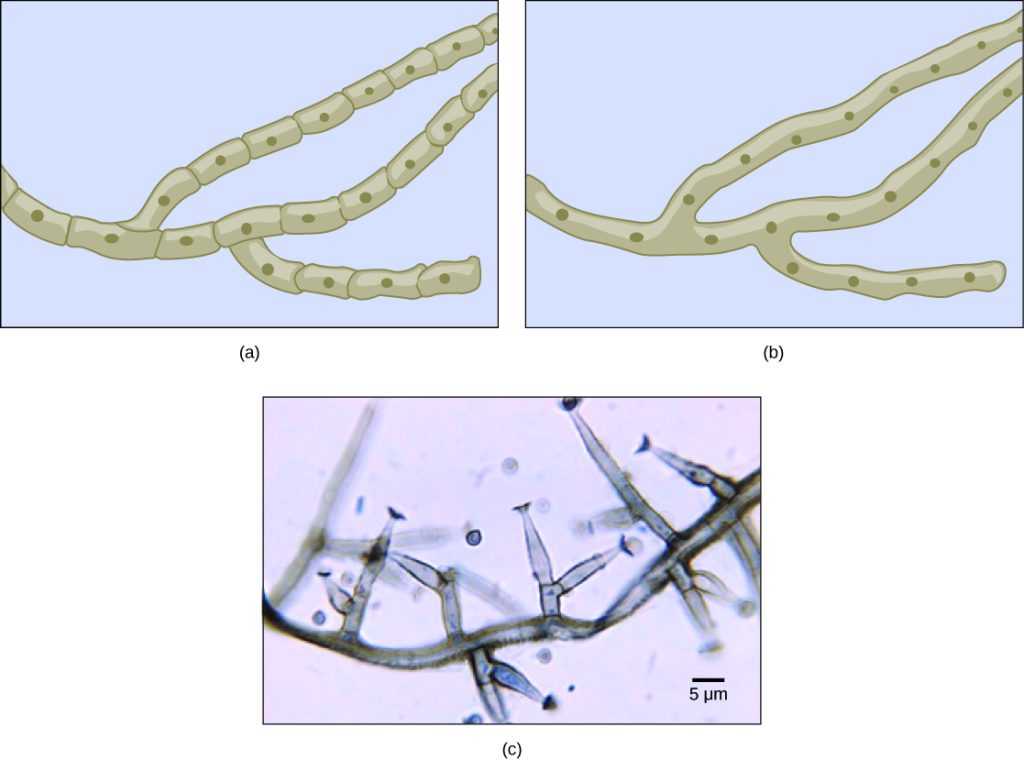
Fungi thrive in environments that are moist and slightly acidic, and can grow with or without light. They vary in their oxygen requirement. Most fungi are obligate aerobes, requiring oxygen to survive. Other species, such as members of the Chytridiomycota that reside in the rumen of cattle, are obligate anaerobes, in that they only use anaerobic respiration because oxygen will disrupt their metabolism or kill them. Yeasts are intermediate, being facultative anaerobes. This means that they grow best in the presence of oxygen using aerobic respiration, but can survive using anaerobic respiration when oxygen is not available. The alcohol produced from yeast fermentation is used in wine and beer production.
Nutrition
Like animals, fungi are heterotrophs; they use complex organic compounds as a source of carbon, rather than fix carbon dioxide from the atmosphere as do some bacteria and most plants. In addition, fungi do not fix nitrogen from the atmosphere. Like animals, they must obtain it from their diet. However, unlike most animals, which ingest food and then digest it internally in specialized organs, fungi perform these steps in the reverse order; digestion precedes ingestion. First, exoenzymes are transported out of the hyphae, where they process nutrients in the environment. Then, the smaller molecules produced by this external digestion are absorbed through the large surface area of the mycelium. As with animal cells, the polysaccharide of storage is glycogen, a branched polysaccharide, rather than amylopectin, a less densely branched polysaccharide, and amylose, a linear polysaccharide, as found in plants.
Fungi are mostly saprobes (saprophyte is an equivalent term): organisms that derive nutrients from decaying organic matter. They obtain their nutrients from dead or decomposing organic material derived mainly from plants. Fungal exoenzymes are able to break down insoluble compounds, such as the cellulose and lignin of dead wood, into readily absorbable glucose molecules. The carbon, nitrogen, and other elements are thus released into the environment. Because of their varied metabolic pathways, fungi fulfill an important ecological role and are being investigated as potential tools in bioremediation of chemically damaged ecosystems. For example, some species of fungi can be used to break down diesel oil and polycyclic aromatic hydrocarbons (PAHs). Other species take up heavy metals, such as cadmium and lead.
Some fungi are parasitic, infecting either plants or animals. Smut and Dutch elm disease affect plants, whereas athlete’s foot and candidiasis (thrush) are medically important fungal infections in humans. In environments with poor in nitrogen, some fungi resort to predation of nematodes (small non-segmented roundworms). In fact, species of Arthrobotrys fungi have a number of mechanisms to trap nematodes: One mechanism involves constricting rings within the network of hyphae. The rings swell when they touch the nematode, gripping it in a tight hold. The fungus then penetrates the tissue of the worm by extending specialized hyphae called haustoria. Many parasitic fungi possess haustoria, as these structures penetrate the tissues of the host, release digestive enzymes within the host’s body, and absorb the digested nutrients.
Reproduction
Fungi reproduce sexually and/or asexually. Perfect fungi reproduce both sexually and asexually, while the so-called imperfect fungi reproduce only asexually (by mitosis).
In both sexual and asexual reproduction, fungi produce spores that disperse from the parent organism by either floating on the wind or hitching a ride on an animal. Fungal spores are smaller and lighter than plant seeds. For example, the giant puffball mushroom bursts open and releases trillions of spores in a massive cloud of what looks like finely particulate dust. The huge number of spores released increases the likelihood of landing in an environment that will support growth.
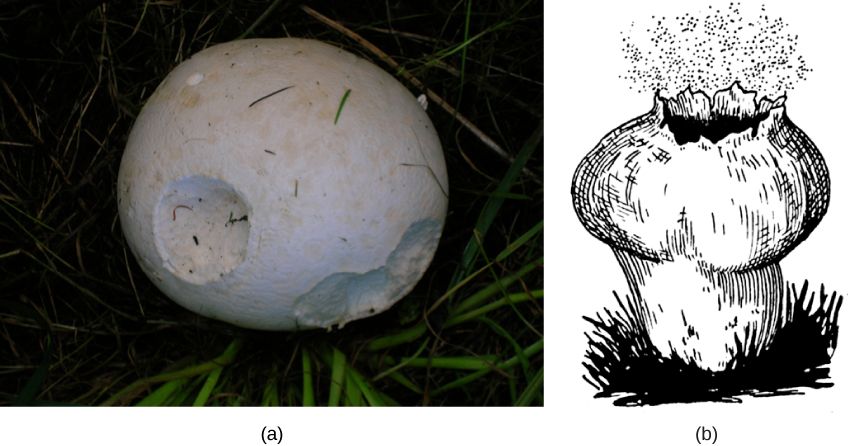
Asexual Reproduction
Fungi reproduce asexually by fragmentation, budding, or producing spores. Fragments of hyphae can grow new colonies. Somatic cells in yeast form buds. During budding (an expanded type of cytokinesis), a bulge forms on the side of the cell, the nucleus divides mitotically, and the bud ultimately detaches itself from the mother cell.
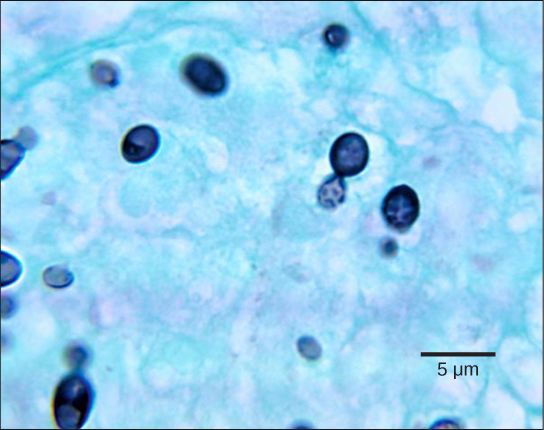
The most common mode of asexual reproduction is through the formation of asexual spores, which are produced by a single individual thallus (through mitosis) and are genetically identical to the parent thallus. Spores allow fungi to expand their distribution and colonize new environments. They may be released from the parent thallus either outside or within a special reproductive sac called a sporangium.

There are many types of asexual spores. Conidiospores are unicellular or multicellular spores that are released directly from the tip or side of the hypha. Other asexual spores originate in the fragmentation of a hypha to form single cells that are released as spores; some of these have a thick wall surrounding the fragment. Yet others bud off the vegetative parent cell. In contrast to conidiospores, sporangiospores are produced directly from a sporangium.

Sexual Reproduction
Sexual reproduction introduces genetic variation into a population of fungi. In fungi, sexual reproduction often occurs in response to adverse environmental conditions. During sexual reproduction, two mating types are produced. When both mating types are present in the same mycelium, it is called homothallic, or self-fertile. Heterothallic mycelia require two different, but compatible, mycelia to reproduce sexually.
Although there are many variations in fungal sexual reproduction, all include the following three stages. First, during plasmogamy (literally, “marriage or union of cytoplasm”), two haploid cells fuse, leading to a dikaryotic stage where two haploid nuclei coexist in a single cell. During karyogamy (“nuclear marriage”), the haploid nuclei fuse to form a diploid zygote nucleus. Finally, meiosis takes place in the gametangia (singular, gametangium) organs, in which gametes of different mating types are generated. At this stage, spores are disseminated into the environment.
Review the characteristics of fungi by visiting this interactive site from Wisconsin-online.
Section Summary
Fungi are eukaryotic organisms that appeared on land more than 450 million years ago, but clearly have an evolutionary history far greater. They are heterotrophs and contain neither photosynthetic pigments such as chlorophyll, nor organelles such as chloroplasts. Because fungi feed on decaying and dead matter, they are termed saprobes. Fungi are important decomposers that release essential elements into the environment. External enzymes called exoenzymes digest nutrients that are absorbed by the body of the fungus, which is called a thallus. A thick cell wall made of chitin surrounds the cell. Fungi can be unicellular as yeasts, or develop a network of filaments called a mycelium, which is often described as mold. Most species multiply by asexual and sexual reproductive cycles and display an alternation of generations. In one group of fungi, no sexual cycle has been identified. Sexual reproduction involves plasmogamy (the fusion of the cytoplasm), followed by karyogamy (the fusion of nuclei). Following these processes, meiosis generates haploid spores.
